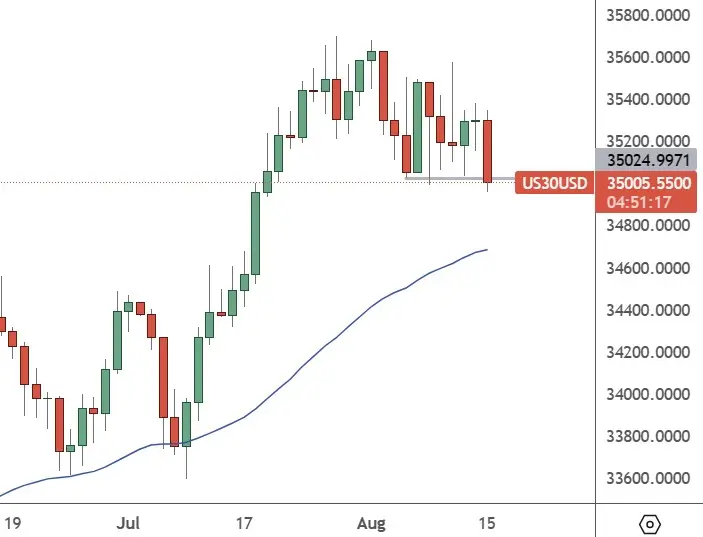The Dow Jones industrial index was testing key support with fears for global growth.
 US30 – Daily Chart
US30 – Daily Chart
The 35,000 level is now key for the US30 index, or stocks could face a more significant correction.
The US market could not capitalize on stronger retail sales, with a print of 0.7%, beating estimates of 0.4%. Lower inflation and consumer strength had painted a stronger picture for domestic demand, but external issues weighed.
US futures slumped lower as Treasury bond yields pushed further into yearly highs, as investors grew concerned about China’s post-Covid recovery. Following softer data, PBOC officials slashed key interest rates, including a benchmark one-year bank lending rate. However, the world’s second-largest economy also has a backdrop of property stress.
“China’s production, consumption and investment slowed more than expected in July despite efforts to boost domestic demand, data released by the National Bureau of Statistics showed,” said Saxo Bank strategists. “Coming on top of a whole host of weaker than expected data recently, the People’s Bank of China responded by unexpectedly cutting two key policy rates for a second time in three months.”
The central bank’s efforts pushed Asian stocks into the red, which hurt the European and US sessions. The Chinese government also suspended the publication of youth unemployment data, worried it would lead to further market disruption.
US Treasury yields are also rising, with the Treasury planning to raise more than $103 billion in bond sales this quarter while adding $132 billion in T-bill sales into the market yesterday.
A Fitch Ratings analyst also told CNBC that the agency could downgrade more lenders, including Wall Street titan JP Morgan, while a proposed rule change by a top banking regulator added to investor concerns. Several worries are building after a big run in tech stocks this year, and investors should be on guard for a pullback.
Large investors could add to any sell-off after a Bank of America poll of asset managers, collectively managing $685 billion in assets, are the least bearish in 18 months, holding the lowest proportion of cash since November 2021. That was the previous market top when central banks started turning off the easy money taps.


